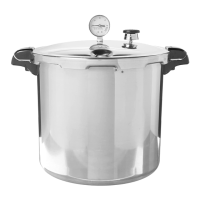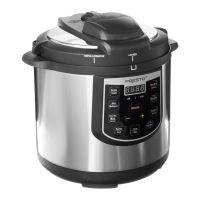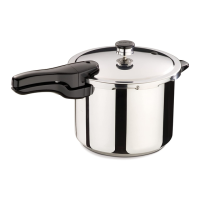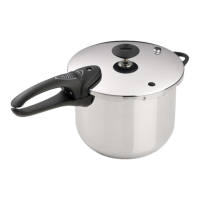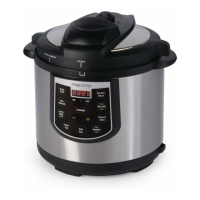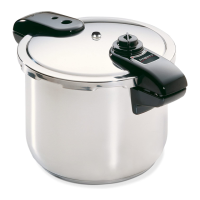2
READ INSTRUCTIONS
BEFORE OPERATING
psi
0
5
10
15
20
5. Do not pressure cook applesauce, cranberries, rhubarb, cereals, pasta, split peas, dried soup mixes, or any dry beans and peas which
are not listed in the timetable on page 29. These foods tend to foam, froth, and sputter and may block the vent pipe, overpressure
plug, and air vent/cover lock.
6. This appliance cooks under pressure. Improper use may result in scalding injury. Make certain pressure canner is properly closed
before operating; cover handles must be directly above the body handles. See “How To” instructions.
7. Do not place the pressure canner or attempt to pressure can or cook in a heated oven.
8. CAUTION! Do not use pressure canner on an outdoor LP gas burner or gas range over 12,000 BTU’s. Doing so may result in
damage to the pressure canner and/or property damage and personal injury.
9. Extreme caution must be used when moving a pressure canner containing hot liquids. Do not touch hot surfaces. Use handles or
knobs.
10. Do not open canner until internal pressure has been completely reduced, air vent/cover lock has dropped, and no steam escapes
when the pressure regulator is removed. See “How To” instructions.
11. To ensure safe operation and satisfactory performance, replace the overpressure plug every time you replace the sealing ring or
sooner if it becomes hard, deformed, cracked, worn, or pitted. It is recommended that the sealing ring and overpressure plug be
replaced at least every three years. Use only genuine Presto
replacement parts.
12. Close supervision is necessary when the pressure canner is used near children. It is not recommended that children use the pressure
canner.
13. When normal operating pressure is reached, gradually lower the heat to maintain the pressure. If the pressure regulator is allowed
to rock vigorously, excess steam will escape, liquid will be evaporated, the canner may go dry, and food may scorch.
14. Do not use this pressure canner for other than intended use.
15. Do not use this pressure canner for pressure frying with oil.
SAVE THESE INSTRUCTIONS
THIS PRODUCT IS FOR HOUSEHOLD USE ONLY.
GETTING ACQUAINTED
Your canner is a special, large capacity pressure vessel designed for home canning
a wide variety of fruits, vegetables, meats, poultry, fish, and seafood. The canner
may also be used to fast cook many of your favorite foods in larger quantities
than can be prepared in a conventional size pressure cooker.
The canner uses pressure to achieve the high temperatures required for safely
processing foods while canning. The United States Department of Agriculture
recommends the pressure canner as the only safe method for canning low-acid
foods: vegetables, meats, poultry, fish, and seafood.
The canner will also cook many foods in one-third to one-tenth the time required
by conventional methods. Pressure cooking preserves flavor and nutrients and
tenderizes tougher cuts of meat. Information for pressure cooking begins on
page 20. It is necessary to follow a few special rules in using and caring for your
canner. Become familiar with the various parts (Fig. A) of the canner described
below and on page 3.
1. PRESSURE DIAL GAUGE
The pressure dial gauge registers pressure in pounds per square inch, or PSI. The pointer moves around the dial
indicating the pressure within the unit. Pressure can be controlled and maintained by adjusting the heat setting
on your stove. Note: The pressure dial gauge can be found in the foam filler of the carton. It is in a white box.
2. PRESSURE REGULATOR
The pressure regulator acts as a safety device to prevent pressure in excess of 15 pounds from building in the
canner. Pressure readings are registered only on the pressure dial gauge. Note: The pressure regulator can be found
in the top foam filler of the carton. It is in a bag identified with the words “.”
3. VENT PIPE
The vent pipe is the primary pressure relief valve and will release pressure in excess of 15 pounds.
The pressure regulator sits loosely on the vent pipe.
1 3 6
7 5
4 82
Model
and series
numbers
(stamped
on side of
canner)
1
2
3
Fig. A

